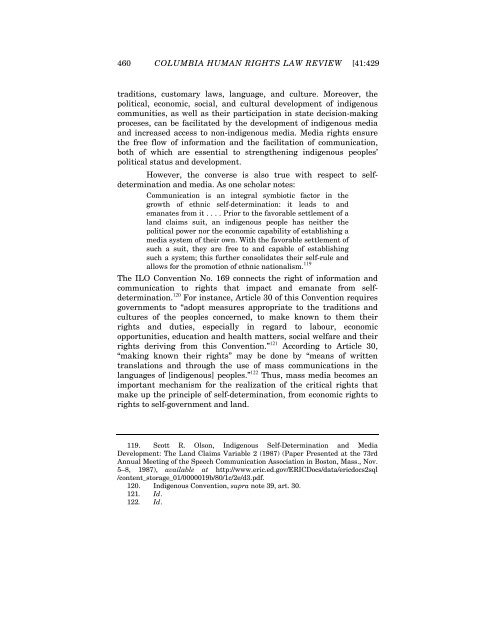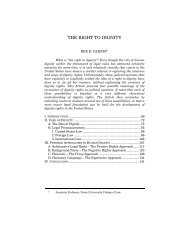A Right to Media? Lorie M. Graham - Columbia Law School
A Right to Media? Lorie M. Graham - Columbia Law School
A Right to Media? Lorie M. Graham - Columbia Law School
You also want an ePaper? Increase the reach of your titles
YUMPU automatically turns print PDFs into web optimized ePapers that Google loves.
460 COLUMBIA HUMAN RIGHTS LAW REVIEW [41:429<br />
traditions, cus<strong>to</strong>mary laws, language, and culture. Moreover, the<br />
political, economic, social, and cultural development of indigenous<br />
communities, as well as their participation in state decision-making<br />
proceses, can be facilitated by the development of indigenous media<br />
and increased access <strong>to</strong> non-indigenous media. <strong>Media</strong> rights ensure<br />
the free flow of information and the facilitation of communication,<br />
both of which are essential <strong>to</strong> strengthening indigenous peoples’<br />
political status and development.<br />
However, the converse is also true with respect <strong>to</strong> selfdetermination<br />
and media. As one scholar notes:<br />
Communication is an integral symbiotic fac<strong>to</strong>r in the<br />
growth of ethnic self-determination: it leads <strong>to</strong> and<br />
emanates from it . . . . Prior <strong>to</strong> the favorable settlement of a<br />
land claims suit, an indigenous people has neither the<br />
political power nor the economic capability of establishing a<br />
media system of their own. With the favorable settlement of<br />
such a suit, they are free <strong>to</strong> and capable of establishing<br />
such a system; this further consolidates their self-rule and<br />
allows for the promotion of ethnic nationalism. 119<br />
The ILO Convention No. 169 connects the right of information and<br />
communication <strong>to</strong> rights that impact and emanate from selfdetermination.<br />
120 For instance, Article 30 of this Convention requires<br />
governments <strong>to</strong> “adopt measures appropriate <strong>to</strong> the traditions and<br />
cultures of the peoples concerned, <strong>to</strong> make known <strong>to</strong> them their<br />
rights and duties, especially in regard <strong>to</strong> labour, economic<br />
opportunities, education and health matters, social welfare and their<br />
rights deriving from this Convention.” 121 According <strong>to</strong> Article 30,<br />
“making known their rights” may be done by “means of written<br />
translations and through the use of mass communications in the<br />
languages of [indigenous] peoples.” 122 Thus, mass media becomes an<br />
important mechanism for the realization of the critical rights that<br />
make up the principle of self-determination, from economic rights <strong>to</strong><br />
rights <strong>to</strong> self-government and land.<br />
119. Scott R. Olson, Indigenous Self-Determination and <strong>Media</strong><br />
Development: The Land Claims Variable 2 (1987) (Paper Presented at the 73rd<br />
Annual Meeting of the Speech Communication Association in Bos<strong>to</strong>n, Mass., Nov.<br />
5–8, 1987), available at http://www.eric.ed.gov/ERICDocs/data/ericdocs2sql<br />
/content_s<strong>to</strong>rage_01/0000019b/80/1c/2e/d3.pdf.<br />
120. Indigenous Convention, supra note 39, art. 30.<br />
121. Id.<br />
122. Id.















